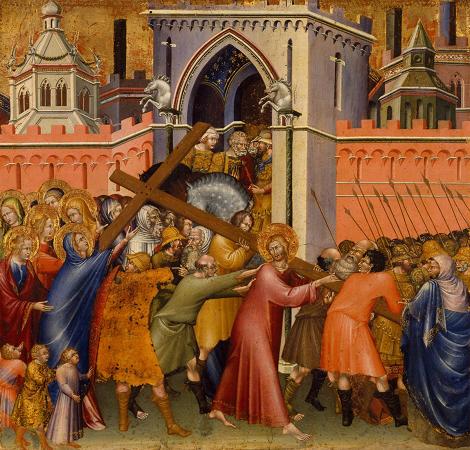Calvary. Golgotha, or Calvary, was, according to the Gospels, a site immediately outside Jerusalem's walls where Jesus was crucified. Matthew's and Mark's gospels translate the term to mean place of skull, in Latin rendered Calvariæ Locus, from which the English word Calvary derives. Its traditional site, identified by Helena of Constantinople, the mother of Constantine the Great, in 325, is at the site of the Church of the Holy Sepulchre. A 19th-century suggestion places it at the site now known as Skull Hill, some 500 m to the north. Historian Joan Taylor bases a location c. 175 m south-southeast of the traditional site on her reading of textual evidence. The recorded form may be a simplified pronunciation of an Aramaic golgolta, corresponding to Hebrew gulgoleṯ skull. English Calvary is the anglicized form of the Latin gloss from the Vulgate, to refer to Golgotha in Luke 23:33,where the Greek text gives rather than the explicit of Matthew 26:33 and Mark 15:22.The adoption the Latin form has a long tradition in English Bible translations, going back to at least the late 10th century, and is retained in Wycliffe's Bible and Tyndale's Bible as well as in the King James Version. By contrast, Martin Luther translates Luke's into German as Schädelstätte. The Latinism is also current in various other languages within the Latin sphere of influence, including Spanish and Italian Calvario, French Calvaire, Polish Kalwaria, Lithuanian Kalvarijos. The church fathers offer different interpretations for the name; either deriving it from a topographic feature resembling a cranium,or alternatively as the site where the skull of Adam was said to be buried, or from the skulls of those executed there. The association of the site with the skull of Adam is expanded in a number of noncanonical Christian writings, including the Kitab al-Magall, the Conflict of Adam and Eve with Satan, the Cave of Treasures, as well as by Patriarch Eutychius of Alexandria. According to these accounts, Shem and Melchizedek traveled to the resting place of Noah's Ark, retrieved the body of Adam from it, and were led by Angels to Golgotha-described as a skull-shaped hill at the centre of the Earth, where also the serpent's head had been crushed following the Fall of Man. While the Gospels merely identify Calvary as a place, Christian tradition since at least the 6th century has described the location as a mountain or hill. The location itself is mentioned in all four canonical Gospels: Matthew 27:33: And when they were come unto a place called Golgotha, that is to say, a place of a skull. Mark 15:22: And they bring him unto the place Golgotha, which is, being interpreted, The place of a skull. Luke 23:33: And when they were come to the place, which is called Calvary, there they crucified him, and the malefactors, one on the right hand, and the other on the left. John 19:17: And he bearing his cross went forth into a place called the place of a skull, which is called in the Hebrew Golgotha. An alternative suggestion, due to Krafft proposes that the reported association with the word skull is a popular etymology of an original name Gol Goatha, interpreted as meaning heap of death, or hill of execution;the supposed toponym Goatha has also been identified, by Ferguson, with the location called GoÊ¿ah in Jeremiah 31:39, in a description of the geography of Jerusalem. There is no consensus as to the location of the site. John describes the crucifixion site as being near the city. According to Hebrews, it was outside the city wall. Matthew 27:39 and Mark 15:29 both note that the location would have been accessible to passers-by. Thus, locating the crucifixion site involves identifying a site that, in the city of Jerusalem some four decades before its destruction in AD 70, would have been outside the city walls and well visible to passers-by. Christian tradition since the 4th century has favoured a location now within the Church of the Holy Sepulchre. This places it well within today's Jerusalem's Old City Walls, which were built in the 16th century. Proponents of the traditional Holy Sepulchre location point out at the fact that 1st-century Jerusalem had a different shape and size from the 16th-century city, leaving the church's site outside the pre-AD 70 city walls.
more...













